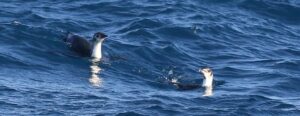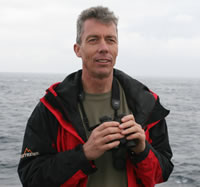By Peter Ryan, onboard scientist, expert in general ornithology, seabird-fishery interactions, evolutionary ecology, marine debris, solid waste management, biology of oceanic islands.
Leg 1, Day 22.
What started out as a day of rather slim pickings ended on a more interesting note. We started transects early to get 4.5 hours done before the ship arrived for a deep CTD (et al.) station which soaked up the rest of the day. As might be expected so far from a breeding island, birds were thin on the ground, and we struggled to reach 11 species during transects. Once on station, the ship gathered a few more species, but until just before supper it looked like the best contenders for pic of the day were either i) the lost Southern Rockhopper Penguin who tried to befriend the flock of White-chinned Petrels (and was roundly rebuffed), or ii) the same flock of White-chinned Petrels squabbling over a large flake of ship’s paint (which also was ultimately rejected). However, just after 19h00 we saw a couple of very odd looking penguins next to the ship, which proved to be juvenile Emperor Penguins – a species that rarely ventures north of 60°S, and that is hard to see away from continental Antarctic ice.
| Antarctic Prion | 20 | Diving petrel spp. | 8 |
| Blue Petrel | 5 | White-chinned Petrel | 2 |
| Wilson’s Storm Petrel | 2 | Wandering Albatross | 1 |
| Light-mantled Albatross | 1 | Soft-plumaged Petrel | 1 |
| White-headed Petrel | 1 | Kerguelen Petrel | 1 |
| Black-bellied Storm Petrel | 1 | Emperor Penguin | + |
| Sthn Rockhopper Penguin | + | Southern Giant Petrel | + |
| Mottled Petrel | + |
Once again no litter was seen. Bull Kelps Durvillaea antarctica still were fairly common, with 8 plants seen in 4.5 hours of transects. All but one was colonized by goose barnacles. It would be interesting to know how long it takes a goose barnacle to grow in these frigid waters. On station, a White-chinned Petrel was seen nibbling at a barnacle attached to a piece of kelp.

